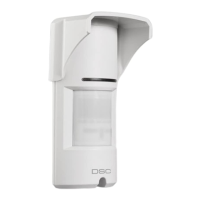12
Environment type Potentiometer position MW jumper position
Low risk At position 5
H
Risk Between positions
3 and 4
H
High risk Between positions
4 and 5
L
Very high risk Between positions
3 and 4
L
Noisy area Between positions
2 and 3
L
Extremely Noisy area At position 1
L
Note: Adjust sensitivity according to environmental conditions!
• Low risk:
very stable environment without interference from parking garages, parking
space, playgrounds, football fields, service roads, etc.
• Risk:
Stable environment with some trees, bushes, flowerpots, planters, etc.
• High risk:
Unstable environment with different types of vegetation and grass and
puddles.
• Very high risk:
Unstable environment with winds and small pets, rats, mice, birds.
• Noisy area:
Unstable environment with vegetation and water sources like swimming
pool, lake, canal, weeds as well as small pets like cats and rabbits.
• Extremely Noisy area:
Very unstable environment subjected to wind, snow, rain, with
vegetation, water and large pets like dogs.
For Example:
If the detector is used in a space which contains several bushes and a swimming pool the
environmental conditions should be considered a "Noisy Area"
8.4 Indications setting
The LC-151 has 3 LEDs that each points at different indication:
1. Green LED indicates PIR detection.
2. Yellow LED indicates Microwave detection.
3. Red LED – Indicates an alarm (logic AND of both Mircowave and PIR).

